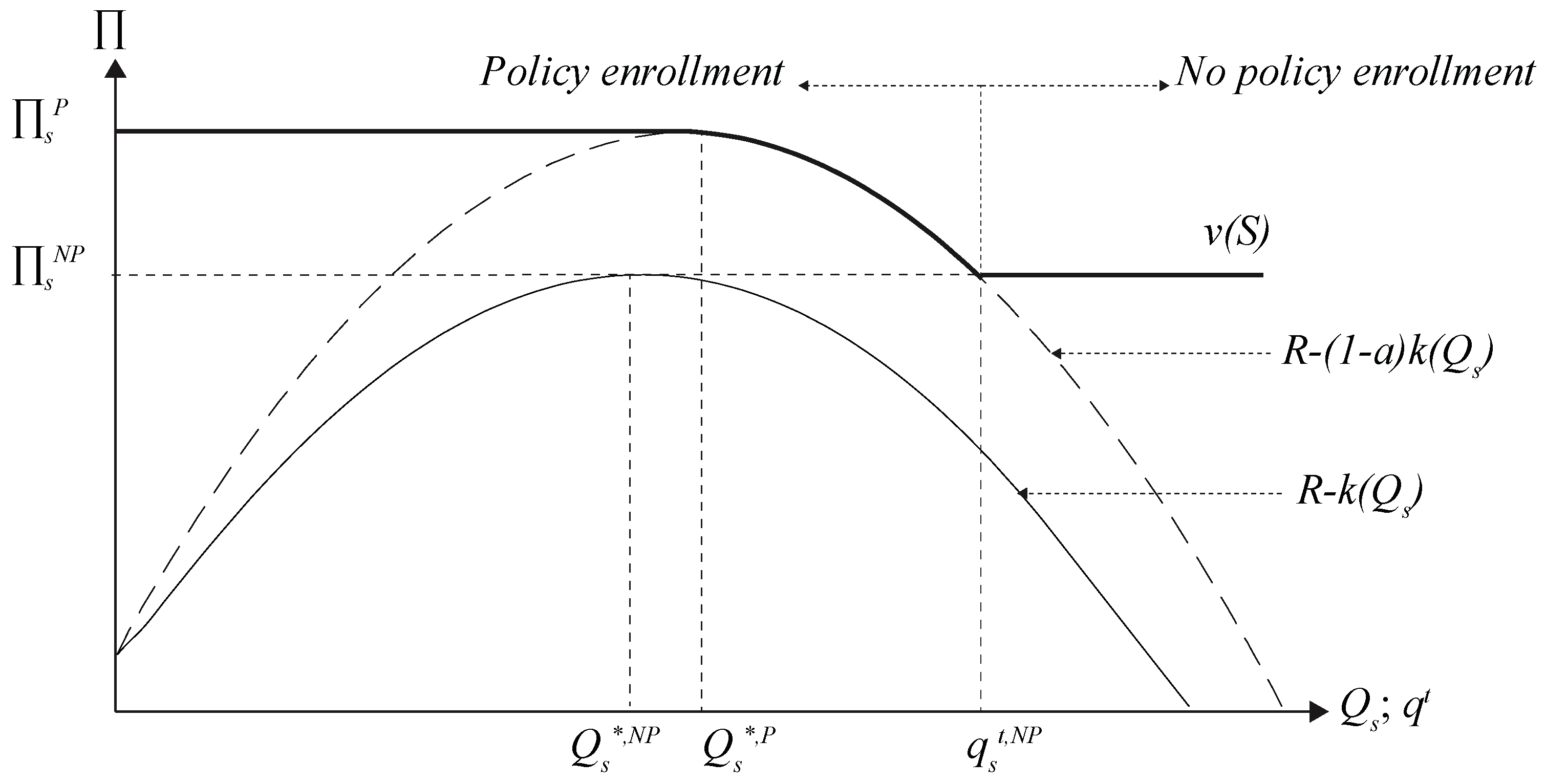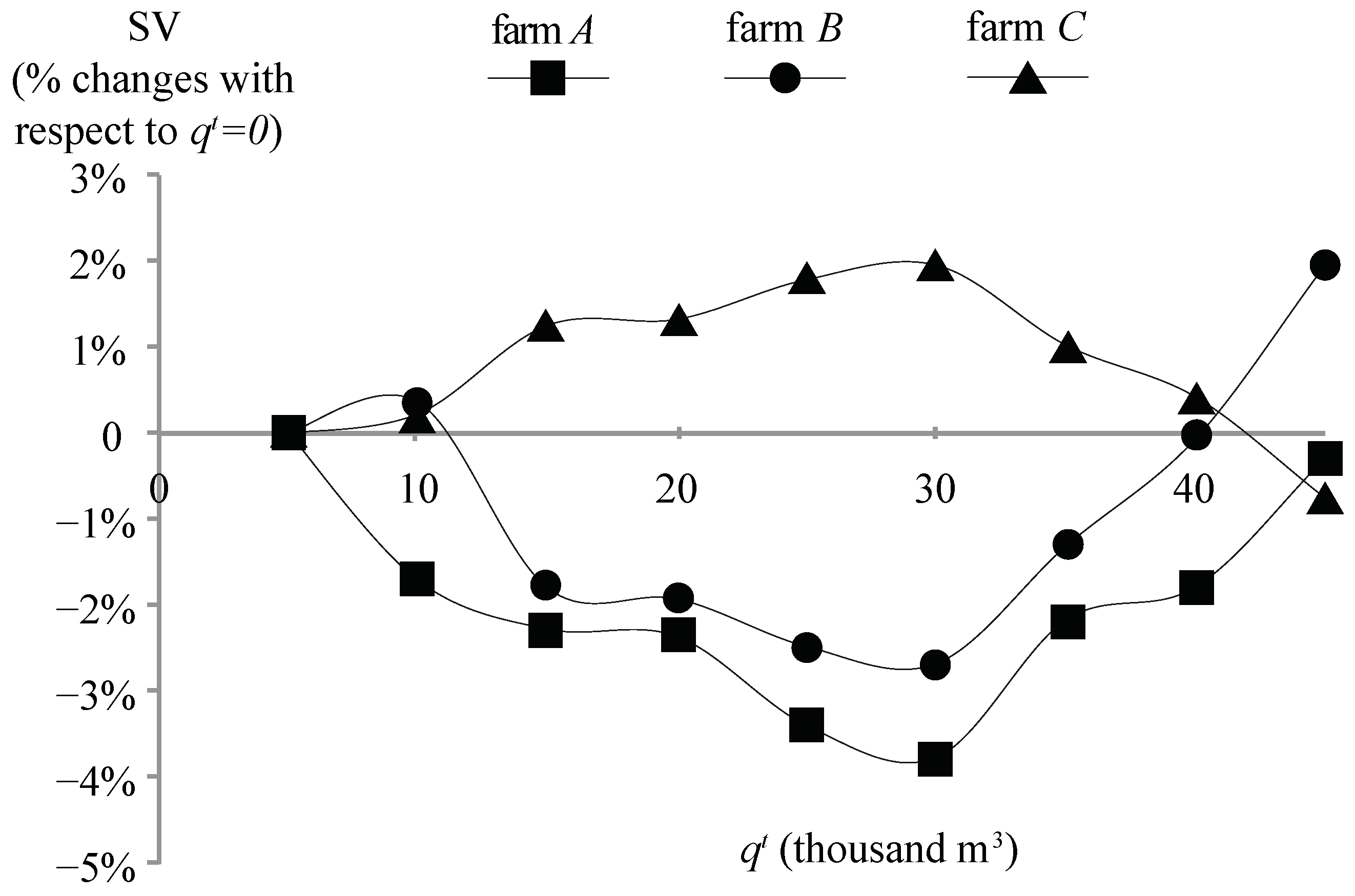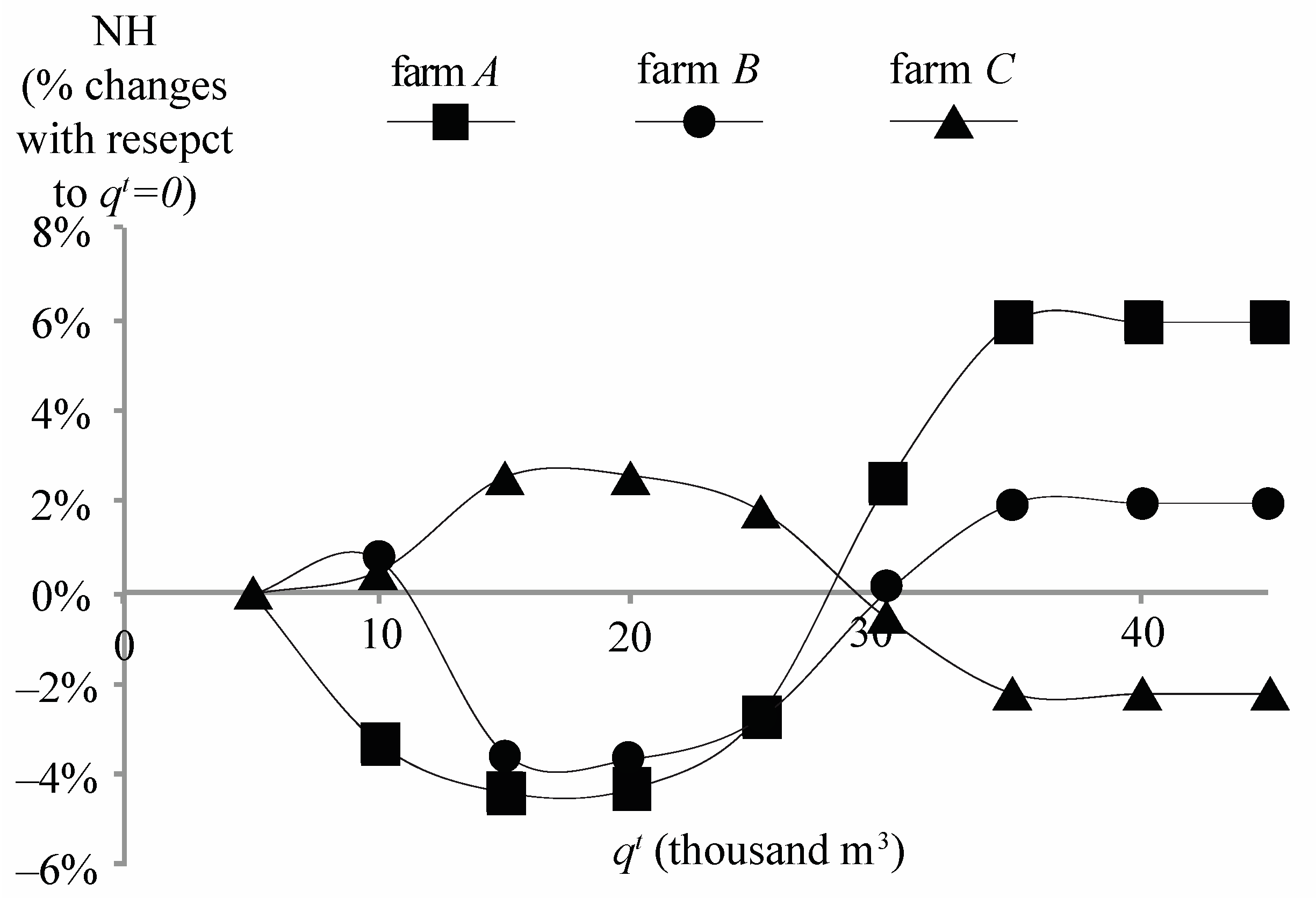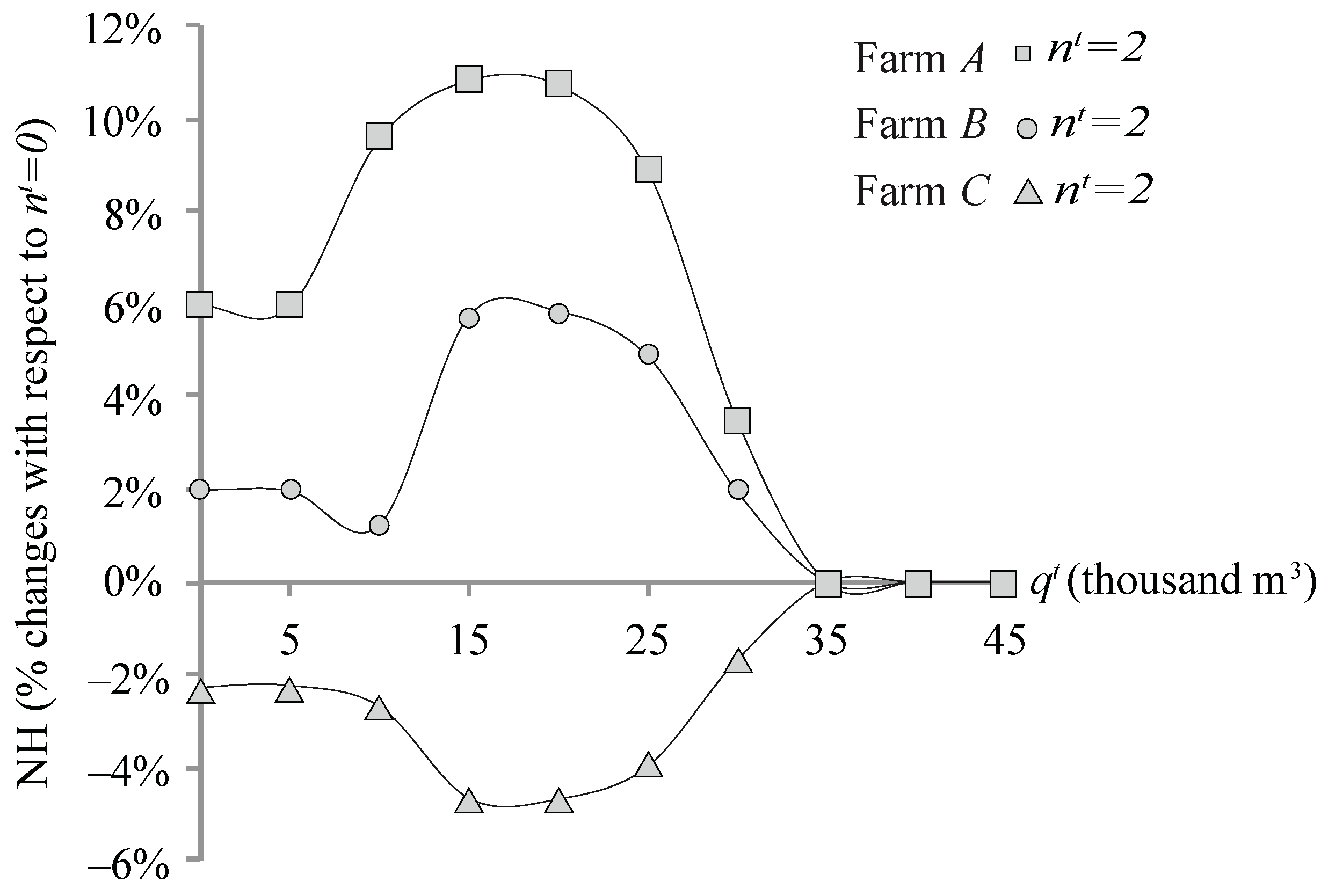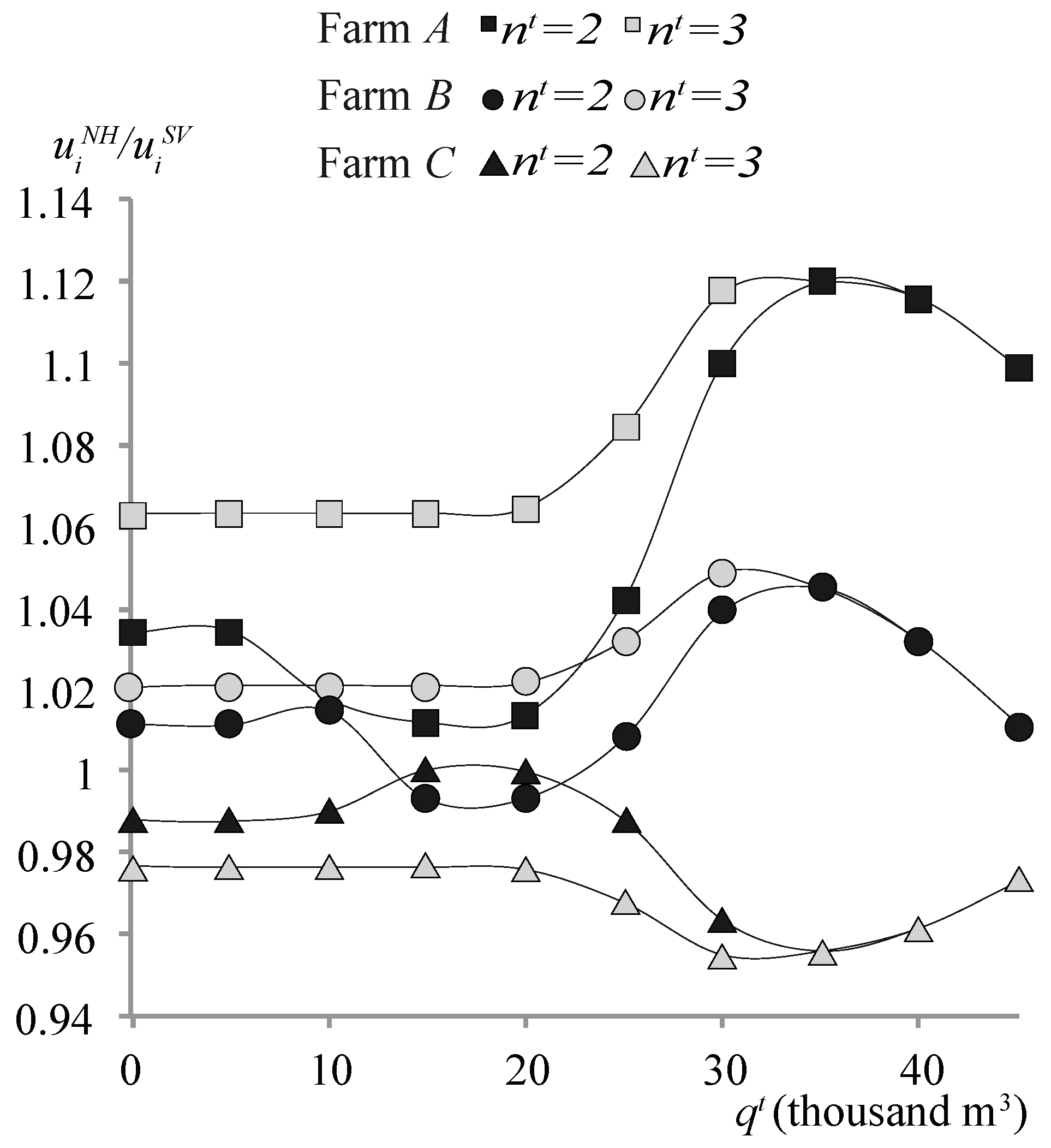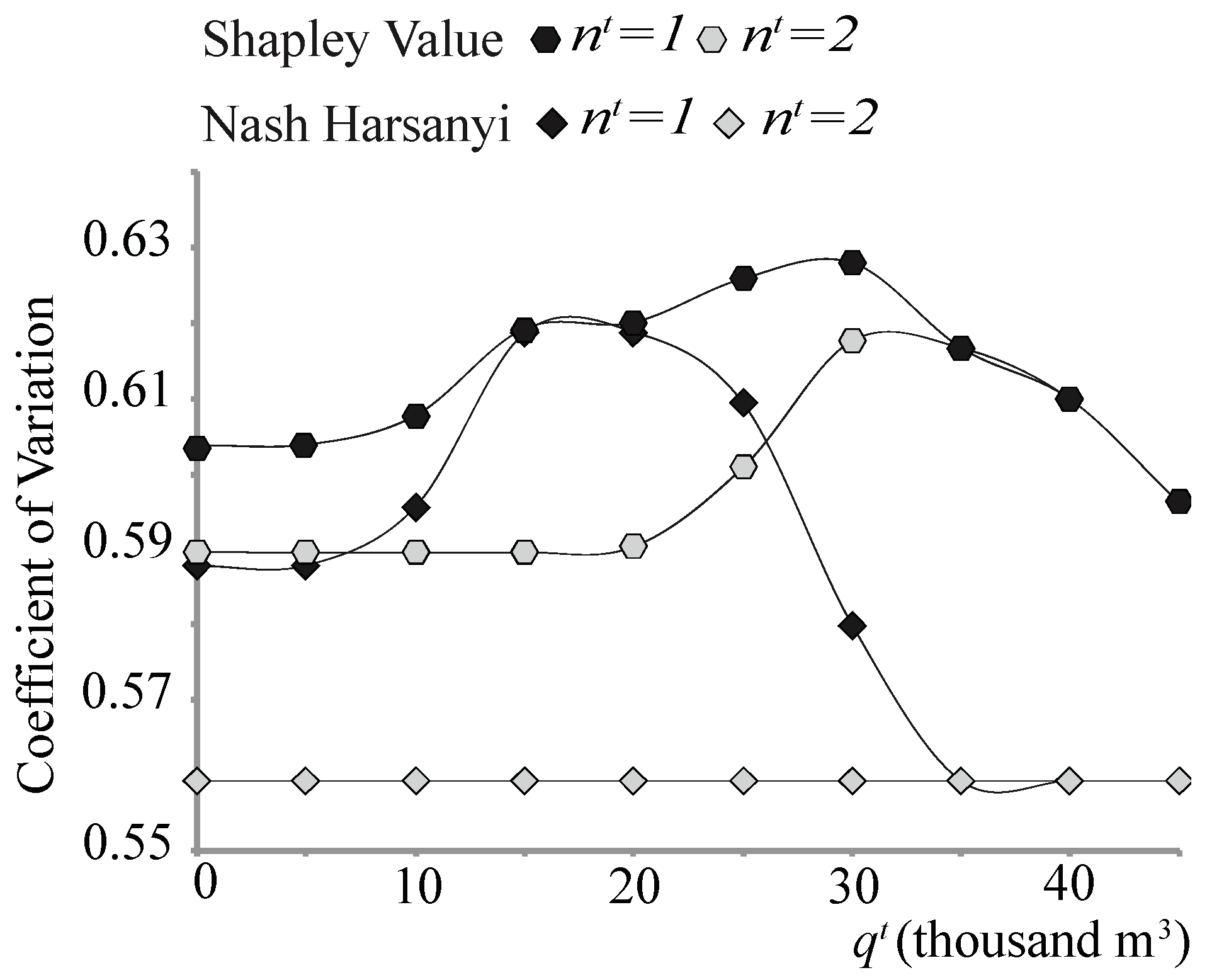2.1. The Caracteristic Function in a Reservoir Construction Game and the Effect of of the q-Rule and of the n-Rule
Assume that a number of heterogeneous farms i, where i = 1, …, n need to build reservoirs in order to make water available for irrigation. Further imagine that the farms in question can pool together their resources to build the reservoir, and that they can gain financial support from the regional administration if MPRs are met. When all the farms cooperate together we have the “grand coalition” defined by N, the set that includes all i farms. Farms can also arrange themselves in coalitions, sub-groups of the entire population; call S the set of the feasible coalitions in the game, with s indicating a given coalition ().
By cooperating, any coalition gains a value v(s), which is the “characteristic function” of the game. The usual assumption on the characteristic function is its superadditivity, namely that the full cooperation among all the farmers leads to the highest aggregated profits. Assuming we have two disjoint coalition s and t (), both belonging to S, superadditivity is defined by: .
Assume in our specific case, that the characteristic function is defined by the following maximization problem, namely each coalition must solve:
s.t.
R is the sum of the individual revenues of the members of coalition s as a function of the water quantity (Qs) given by the reservoir. We assume that individual revenues are given by quadratic functions in the water quantity, so that the inverse demand functions are linear. k(Qs) is the cost of the reservoir construction exhibiting economies of scale (k’(Qs) > 0 and k’’(Qs) < 0) thus satisfying the super-additive assumption. P is a binary variable that indicates whether the coalition participates or not in the RDP. is the share of the costs covered by the RDP. Finally, Equation (4) defines the MPR as a q-rule that links the financial support to the (exogenously determined) minimum size (qt) of the reservoir. The coalition has to maximize the difference between the sum of the individual benefits generated by irrigation, and the costs of constructing a (possibly) collective reservoir, which thus depends on the aggregate amount of water requested.
The problem entails a binary variable and cannot be solved analytically. There are two choice variables: the water quantity demanded by the farms (the reservoir size), and whether or not it is profitable to participate in the RDP given the threshold qt and the share of the costs covered by the RDP. To analyse the problem we first assess the optimal reservoir size and profits with and without the financial support, and second we assess the effect of the q-rule. These results are then used to define the characteristic function.
In case there is no public support (α = 0), the first order conditions are given by the point of intersection of the aggregated marginal revenue function and the cost function: . The result is the optimal reservoir size in the absence of the financial support (superscript “NP”) Qs*,NP, and the associated profits ΠsNP(Qs*,NP). qt = 0, the first order conditions are similar to the previous case: , leading to the optimal reservoir size Qs*,P and coalition profits ΠsP(Qs*,P). Given the assumptions on the shapes of the functions we have that Qs*,P > Qs*,NP and ΠsP(Qs*,P) > ΠsNP(Qs*,NP).
The introduction of the q-rule entails that the characteristic function could assume three values, depending on the level of the q-rule relative to the optimal reservoir sizes. First, as long as the q-rule is not binding,
Qs*,P ≥
qt, the problem is trivial. The coalition participates in the RDP, the q-rule has no effect, and the value that coalition
s obtains is
ΠsP(Qs*,P). If we increase
qt above
Qs*,P, the size of the reservoir is given by the q-rule level and the resulting profits are
ΠsP(qt). However, the coalition still participates in the RDP as long as
qt ≤
qst,NP, where
qst,NP is the level in the q-rule at which
ΠsP(
qt) =
ΠsNP(
Qs*,NP). Finally, for
qt level higher than
qst,NP, the coalition obtains the profits in the absence of the policy support:
ΠsNP(
Qs*,NP). Accordingly, the characteristic function of the game when a q-rule applies is:
The theoretical analysis previously described is summarized graphically in
Figure 1. Profits with and without financial support increase up to the level of the optimal reservoir size, and then decrease. The characteristic function is constant as long as the q-rule is lower than the optimal reservoir size when costs are partially covered by the regional administration. Then it decreases up to the level of profits without the financial support, which set a floor on the characteristic function level.
The introduction of an n-rule, by setting a threshold on the minimum number of participants (
nt) into the game would add another constraint that changes Equation (4) into:
where |
s| is the cardinality of the set
s, i.e., the number of members in the coalition. The characteristic function thus becomes:
The MPRs not only affect the characteristic function of a single decisional unit but they change the structure of the cooperative game. First, they increase the attractiveness of the full cooperation with respect to the other possible arrangements. For example, assume that there are three players (I = A,B,C) having different revenue function shapes with QA*,P < QB*,P. In addition, recall that given the shape of the cost function we have QA*,P < QB*,P < Q(A,B)*,P. As long as qt ≤ QA*,P, QB*,P the gains from cooperation, are simply given by the economies of scale due to the cost function, since any coalition benefit from the financial support. Further increases in the threshold add to the economies of scale the fact that for singleton coalitions it is relatively more difficult to access the financial support, whereas it is still feasible for the two-players coalition. Cooperation becomes more and more attractive because the q-rule imposes costs on the smaller coalition. This continues as long as qAt,NP, qBt,NP ≤ qt < q(A,B)t,NP, namely when only singleton coalitions do not enroll in the policy, and thus the gains from cooperation are at the their highest level.
Second, if farms are heterogeneous, MPR affects the game asymmetrically. The increases in the gains from cooperation are first due to the decrease in the profits of player A, and then due to the decrease in the profits of player B. This asymmetry influences the relative bargaining power within the grand coalition. Consider the two q-rule levels qt1 < qt2 < QN*P, which do not affect the worth of the grand coalition. Imagine a coalition (A,C) for which v(A,C) = ΠsP(Qs*,P) given a fixed qt1 and v(A,C) = ΠsNP(Qs*,NP) given a fixed qt2. The increase in the threshold reduces the potential worth of (A,C), and increases the relative gains from full cooperation. Moreover, the bargaining power of player B is thus greater now, since coalition (A,C) has now a lower opportunity cost of fully cooperating with player B (or, in other terms, cooperation for them becomes relatively more attractive).
2.2. Shapley Value and Nash–Harsanyi Solution
How to share the worth of cooperation in such a way that all of the
i players enter the grand coalition? Call
ui* the worth attributed to the
ith agent in the full cooperation setup. The “core” of a cooperative game defines the set of rationally acceptable solutions
ui* and it is defined by the following system of inequalities [
37]:
Equation (8) is the rationality constraints, which state that a solution, a share of the grand coalition worth, must be such that all the people cooperating gain more in the full cooperative agreement than in any possible sub-groups, including the singleton coalitions when players act non-cooperatively. Equation (9) is the efficiency constraint, stating that the entire wealth of the grand coalition is to be shared among the players. The non-existence of a solution to the system of Inequalities (8) and (9) defines an “empty” core. In turn, a game characterized by an empty core is considered to be unstable, since there is no possibility to share the grand coalition worth in such a way that all players find such an arrangement profitable. In this condition, most likely the grand coalition will not form. In addition, if it does not meet the core conditions, a sharing rule will not be accepted by the whole set of players.
The SV is a unique solution that in the case of convex games undoubtedly satisfies the previous inequalities, and is thus in the core [
38,
39]:
where for ∀
i ∈
N,
|s| is the number of members in the coalitions, and
n is the total number of participants in the game [
29]. Equation (10) states that the worth attributed to the
ith player through the SV is given by its average marginal contribution to any possible grouping of the players. The marginal contribution of any player
i is defined by the expression
v(
s) −
v(
s − {
i})
, which indicates that is given by the value obtained by the coalition minus the value obtained by the coalition when player
i is not a member of it. The greater the contribution of a player is to a coalition, the greater his or her final share of the grand coalition is worth.
An example clarifies what is the marginal contribution of a player, and how could be potentially affected by changes in MPR levels. Imagine we have three farmers (i = A,B,C) that as singletons have profits of v(A) = 10, v(B) = 20 and v(C) = 30. Further consider that v(A,B) = 40. Imagine there are policy incentives linked to a MPR level of three farmers (nt = 3), so that by both pooling resources and receiving the subsidy they obtain: v(A,B,C) = 100. In this situation, the marginal contribution of player C to the coalition (A,B,C) is given by: v(A,B,C) − v(A,B) = 60. Now imagine that there is an alteration in the MPR level so that the n-rule becomes nt = 2, and v(A,B)’ = 65. The marginal contribution of C is now v(A,B,C) − v(A,B)’ = 35. Everything else constant, in the second situation the bargaining power of player C is greatly reduced, even though neither the aggregated final payoff, nor his singleton payoff has changed. MPR thus might increase the gap between the cooperative arrangements that meet the requirements of the MPR and the smaller groupings that are administratively excluded, resulting in changes in the bargaining power of the players that ultimately affect the distribution of the benefits.
The NH solution is the extension to the n-person game of the Nash solution to the bargaining problem. The solution is given by the result of the following maximization problem:
subject to the core conditions (Equations (8) and (9)). Equation (11) indicates that the NH solution is obtained by maximizing the product of the gains from cooperation with respect to the non-cooperative outcomes. Thus, the NH is relatively more sensible to changes in the in singleton coalitions’ worth than to changes in the value obtained by e.g., 2-players coalitions.
These solutions are often compared in terms of the stability of the wealth allocation. There are a number of methods to compare the different CGT solutions in terms of stability. One of these is Propensity To Disrupt index (PTD) [
40], that has been often used as an indicator of the stability of cooperation [
29]. The PTD for player
i measures the ratio between how much the players other than
i would lose if
i leaves the grand coalition and the loss that
i would face. The lower the PTD, the higher player
i gains from cooperating with respect to the other players and so the relatively higher are his or her incentives to cooperate. Mathematically, the PTD is defined by:
In the next section we provide an example that more closely resembles the problem of the collective reservoir and the subsidy schemes, to which we apply the SV and the NH solution.
2.3. Numerical Application
Here we apply the previous analysis to a numerical example for illustrative purposes, parameterizing the model as much as possible on actual data while maintaining the tractability and intelligibility of the game. The example is based on secondary data taken from the E-R region, from an area where irrigation water is managed by the Consorzio di Bonifica della Romagna Occidentale (CBRO), a local Water User Association. The choice of the area is due to the high rate of successful applications to the measure 125 of the regional RDP, since eight out of sixteen applications in E-R were submitted by group of farmers through the CBRO.
Assume there are three farms (
i =
A,
B,
C) that are characterized by different levels of water productivity. As a numerical example, we take the revenue function from a mathematical programming model elaborated by Viaggi et al. [
41]. The model is a farm profit maximization problem where land allocation and irrigation are some of the decision variables, and water availability is one of the key constraints. The original model is applied to an area within the CBRO territory where farms are grouped through a cluster analysis, where the discriminants are farm size and share of land allocated to crop types [
41]. In this paper, we use three of the five original farm clusters: cluster 2 (farm
A), cluster 3 (farm
B), and cluster 4 (farm
C). All three of the farm clusters are characterized by a relatively high share of land allocated to permanent crops (highly dependent on water availability) and they represent the most frequent farm typologies in the area. Here the results from [
41] are simplified by using a quadratic interpolation (to be consistent with the previous analysis) of the gross margin results generated by a sensitivity analysis on water availability, not considering the costs of the water provision:
where
qi is the water quantity per hectare, and total water used by the farm is
. The farm specific parameters are listed in
Table 1. The three farms are relatively heterogeneous in terms of both land availability, and water productivity. Farm
A is the smallest and the one with the steepest revenue function.
Restricting focus to a three-player game ensures the tractability of the problem and the comprehensiveness of the results. However, there is a clear trade-off between tractability and (i) the ability of the model to represent the heterogeneity of the composition of the farmers in the group; and (ii) the degree of discrepancy with respect to the actual number of users in each reservoir, which are in a range of 20–50 [
42].
The construction costs of the reservoir are given by the annualization (λ = 0.05) of the investment costs derived from the following function: 140(Qs)0.641. The cost function was formulated in collaboration with officials of the CBRO, and represents the interpolation of the costs assessment of a number of planned reservoirs with different capacity levels. Moreover, we introduce running costs (c) to account for electricity and management. We assume that running costs are dependent on the coalition size and account for economies of scale in management, technical choices, and more likely water scarcity for the smaller reservoirs. According to CBRO officials, these are key factors to be considered when decisions on building reservoirs are made. In the absence of more precise functions, marginal running costs are assumed to be dependent on the number of reservoirs user: c = 0.45 if |s| = 1, c = 0.30 if |s| = 2, and c = 0.15 if |s| = 3. We do not address the problem of the connection costs among the farms and the reservoir as it is not possible to properly represent the complexity of such an issue (spatial elements, congestion costs) in a three-player game. However, CBRO officials report that these costs can be higher than 50% of total costs for existing reservoirs. The drawback is thus that the model certainly overestimates the reservoir capacity. The final cost function is .
We explore the characteristic function, the SV and the NH solution for different levels of q-rules and n-rules (nt = 1, nt = 2, nt = 3) in case of α = 0.7. Once again, the tractability of the results imposes a simplification and scaling down of the MPRs applied for the example described here (nt = 0, and qt = 50,000 m3 are the actual levels).
